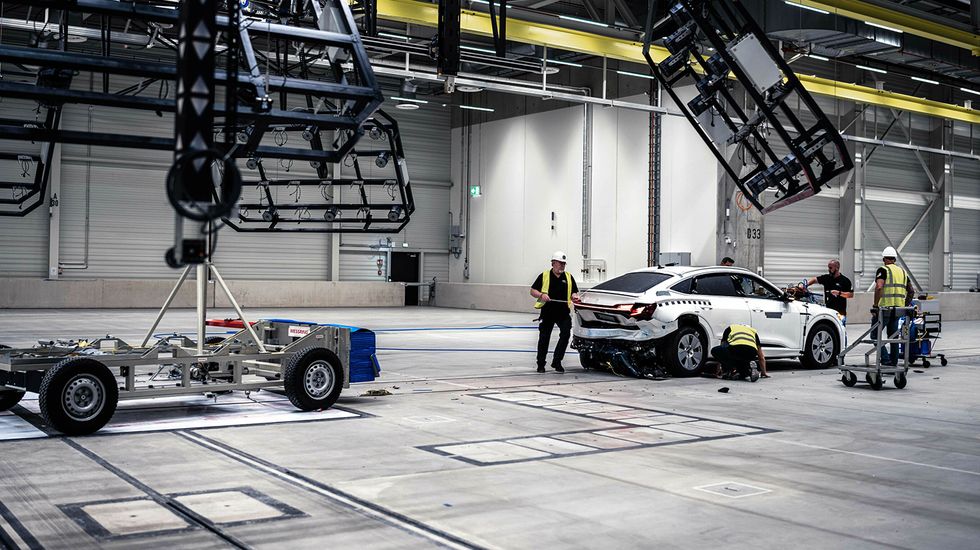- Audi opens incampus Ingolstadt technology park in Germany, having turned the grounds of a former refinery into a tech hub that is developing VW Group software for all new models under the Cariad division.
- The Audi facilities on site include a new Vehicle Safety Center with a large indoor hangar for crash testing work.
- The Ingolstadt hub also houses Technische Hochschule Ingolstadt, which is working on connected and automated driving technologies.
After years of painstaking work, Audi has opened a new research and development site in its home city of Ingolstadt, one that will develop the software for the automaker’s next generation of electric cars.
Dubbed simply incampus, the technology park will serve as the home of Cariad—VW Group’s in-house software division—as well as Audi’s new Vehicle Safety Center, while also hosting a number of other companies and institutions including Technische Hochschule Ingolstadt.
And the site itself is perhaps emblematic of Audi’s electrification revolution, with the company spending seven years on soil remediation efforts on the technology park’s grounds, which formerly hosted a refinery.
This month marked the building project’s completion, but Cariad has been based here since 2020, with 2000 employees working on software for several VW Group brands, including Porsche. This software will go into Premium Platform Electric (PPE) models that will be sold under Audi and Porsche brands.
“Together with Audi and Porsche, we’re developing the 1.2 electronics architecture here, the Volkswagen Group’s most important software architecture of the coming years. We’re utilizing modern work processes and tools for close collaboration and higher speed,” said Peter Bosch, CEO of Cariad.
If the name Cariad sounds familiar, especially in conjunction with the PPE architecture, it’s probably for less than positive reasons. Delays at Cariad earlier in the decade have pushed back the production debuts of PPE models by entire years, and have also reportedly played no small role in the surprise departure of VW Group CEO Herbert Diess in June 2022.
As a result, progress at Cariad has been a top priority for VW Group’s new CEO Markus Oliver Blume, who had led Porsche as CEO since 2015.
To be fair, the Cariad division was given several monumental tasks in a very short span of time—tasks that would have required several separate companies. Not only is Cariad charged with developing automated driving, but it is also working on tech platforms, digital driving experience, and cloud services for all VW Group brands simultaneously.
But the largest building in the new tech hub—a quarter of a kilometer long—will host Audi’s new Vehicle Safety Center, with crash testing facilities inside set up to recreate a variety of accidents.
“For instance, there’s an integrated crash arena in a pillar-free space of 50 by 50 meters. The crisscrossing crash lanes there enable test configurations that include vehicle-on-vehicle collisions,” the automaker notes.
Technische Hochschule Ingolstadt, meanwhile, has a smaller two-story building on the new site, hosting a lab for digital testing of automated and connected driving—another major goal for the automaker in the coming years as higher levels of automated driving continue to debut around the globe. The Automated Driving Alliance is also based in the new technology park, with Bosch and Cariad as partners.
The new hub wouldn’t be modern without concern for energy usage. The site features an Energy Control Center to gather surplus heating and cooling energy (volume of up to 3000 cubic meters), with the technology park importing green energy from off-site.
But in the future, the incampus will seek to produce as much renewable energy as it actually uses, thereby minimizing its carbon footprint further.
It remains to be seen whether Cariad will be able to catch up in the coming years, not only when it comes to the product timeline of PPE architecture cars, but in software as a whole. VW has admitted on several occasions in the past few years that the automaker has been lagging behind Tesla and others in software development, which has become central in EVs.
The VW Group also wants to catch up with automated driving tech—another sore point for Audi in recent years, following abandoned plans to introduce Level 3 automated driving in its flagship sedan. But for now, getting new EV models out of development and into production is the automaker’s primary goal.
Should Audi seek to introduce hands-off and eyes-off SAE Level 3 tech in its vehicles in coming years, or is this technology too problematic now to be worthwhile? Let us know what you think.

Jay Ramey grew up around very strange European cars, and instead of seeking out something reliable and comfortable for his own personal use he has been drawn to the more adventurous side of the dependability spectrum. Despite being followed around by French cars for the past decade, he has somehow been able to avoid Citroën ownership, judging them too commonplace, and is currently looking at cars from the former Czechoslovakia. Jay has been with Autoweek since 2013.
Read the full article here



